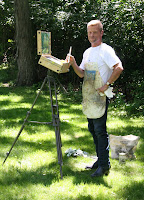


After painting on location for about 16 years, I can finally get past the challenges of controlling the oil colors well enough to record what I see and, instead, I can focus on the momentary conditions of light, atmosphere, and mood. That makes the experience more satisfying and the paintings more appealing to observers.
Recently I went back to a foot bridge over the Croton Reservoir to paint a familiar scene, and I spent about 2 hours capturing the layers of greens influenced by the light and the distance. I knew from the moment I started the painting that the most important aspects of the scene were the way the sunlight cut between the first and second arc of trees and the clouds bleached by the hot, mid-day sunlight. Painting the land formations depended on balancing warm and cool greens (warm: ultramarine blue + cadmium medium; cool: Winsor blue + cadmium lemon), as well as the dark, middle, and light values; and recording the cloud pattern called for softening the edges of shapes painted with warm whites (titanium white with a touch of transparent oxide red) and blues (ultramarine and Winsor blue).
Lots of people stopped as they were biking and jogging over the bridge, and they made both stupid and profound comments. One woman asked if I had painted the picture, making me wonder if she thought I bought it a Wal Mart and brought it to the location; and a serious biker stopped to ask if I might sell the painting. The man didn't actually purchase the painting, but I was flattered that he thought my painting captured all the reasons he enjoyed nature.
P.S. Everyone who stopped to admire my painting was pleased that I eliminated the telephone wires crossing over the dam.











